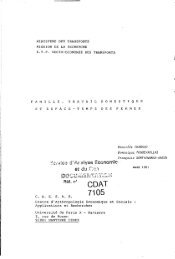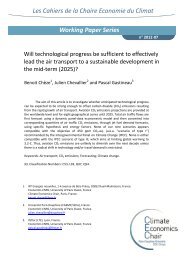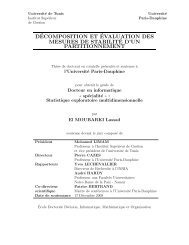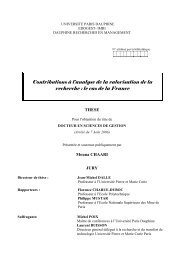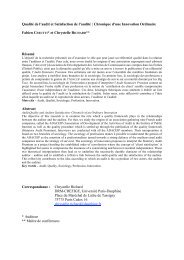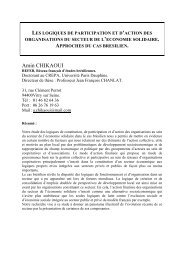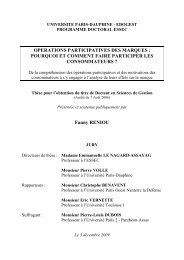TH`ESE Docteur de l'Université Paris-Dauphine Morgan HERVÉ ...
TH`ESE Docteur de l'Université Paris-Dauphine Morgan HERVÉ ...
TH`ESE Docteur de l'Université Paris-Dauphine Morgan HERVÉ ...
Create successful ePaper yourself
Turn your PDF publications into a flip-book with our unique Google optimized e-Paper software.
2008, another reason invoked 4 not to distribute allowances to installations<br />
was the fact that the CITL and ITL were not yet connected. The year after,<br />
only 23 out of the 30 countries participating in the EU ETS issued their<br />
2010 allowances to their installations prior to the February, 28th <strong>de</strong>adline<br />
(accounting for 78% of the total cap). The main reason for those <strong>de</strong>lays was<br />
legal challenges of NAP revisions by the EC 5 .<br />
Submitted NAPs have been evaluated on the basis of several criteria by<br />
the EC including the stringency of their emissions caps and related parameters<br />
(use of offsets, auctioning of allowances, etc.), projected emissions<br />
trends and emissions reduction potential. This has been performed with<br />
the achievement of the Kyoto targets in mind (ETS sectors and non-ETS<br />
sectors) - namely, too high a cap might prevent reaching those targets. The<br />
EC had three months to evaluate submitted plans. On average, Western<br />
European countries have slightly reduced the emissions cap compared to<br />
phase I in comparison to Eastern European countries’ NAP II drafts who<br />
attempted to increase the cap between the two phases for an i<strong>de</strong>ntical installations’<br />
perimeter 6 .<br />
Initial draft allocations submitted by member states were mostly slashed<br />
by the EC both regarding too high a cap and too large the share of compliance<br />
which could be achieved with Kyoto offsets. For instance in November<br />
2006, the first ten draft emissions cap levels reviewed (including Germany<br />
and Eastern European countries) were severely cut by the EC (minus 7%,<br />
i.e. 63.9 MtCO2) and Ireland’s initial plan to use up to 50% of Kyoto offsets<br />
for compliance with the EU ETS was reduced to 21% 7 .Earlyestimates<br />
for phase II cap indicated that circa 2,081 MtCO2e would be allocated on<br />
average per annum between 2008 and 2012 which is 10.5% less than initially<br />
planned by member states in their earlier drafts and 9.5% less than in the<br />
first phase 8 .<br />
In early 2007, the first complaints towards the EC regarding NAPs reviews<br />
were addressed. Many voices were raised against slashed NAPs but only<br />
afewcountries(EasternEuropecountriesmostly)actuallyprocee<strong>de</strong>dto<br />
legally challenge the EC as regards revised allocation plans. In January<br />
2007, Slovakia first announced its intention to legally challenge the EC. In<br />
April 2007, Poland, the Czech Republic, Slovakia and Hungary had filed<br />
an appeal against the EC with the European Court of Justice. These appeals<br />
were motivated on grounds that the revised allocations (1) prevented<br />
4 By the UK and Ireland to be more specific.<br />
5 Tendances Carbone (2010, [7])<br />
6 Tendances Carbone (2006, [8])<br />
7 Tendances Carbone (2006, [9])<br />
8 Tendances Carbone (2007, [10])<br />
14



